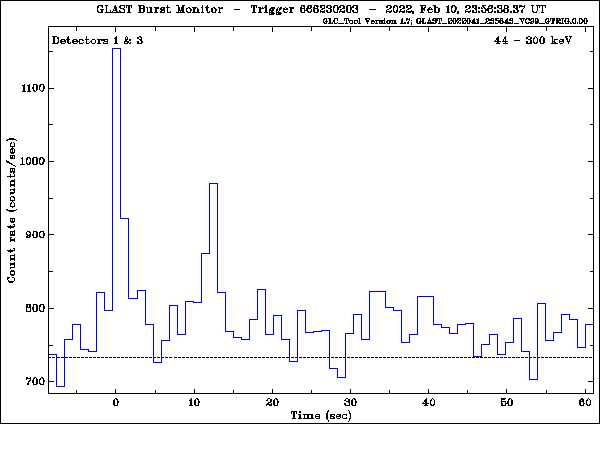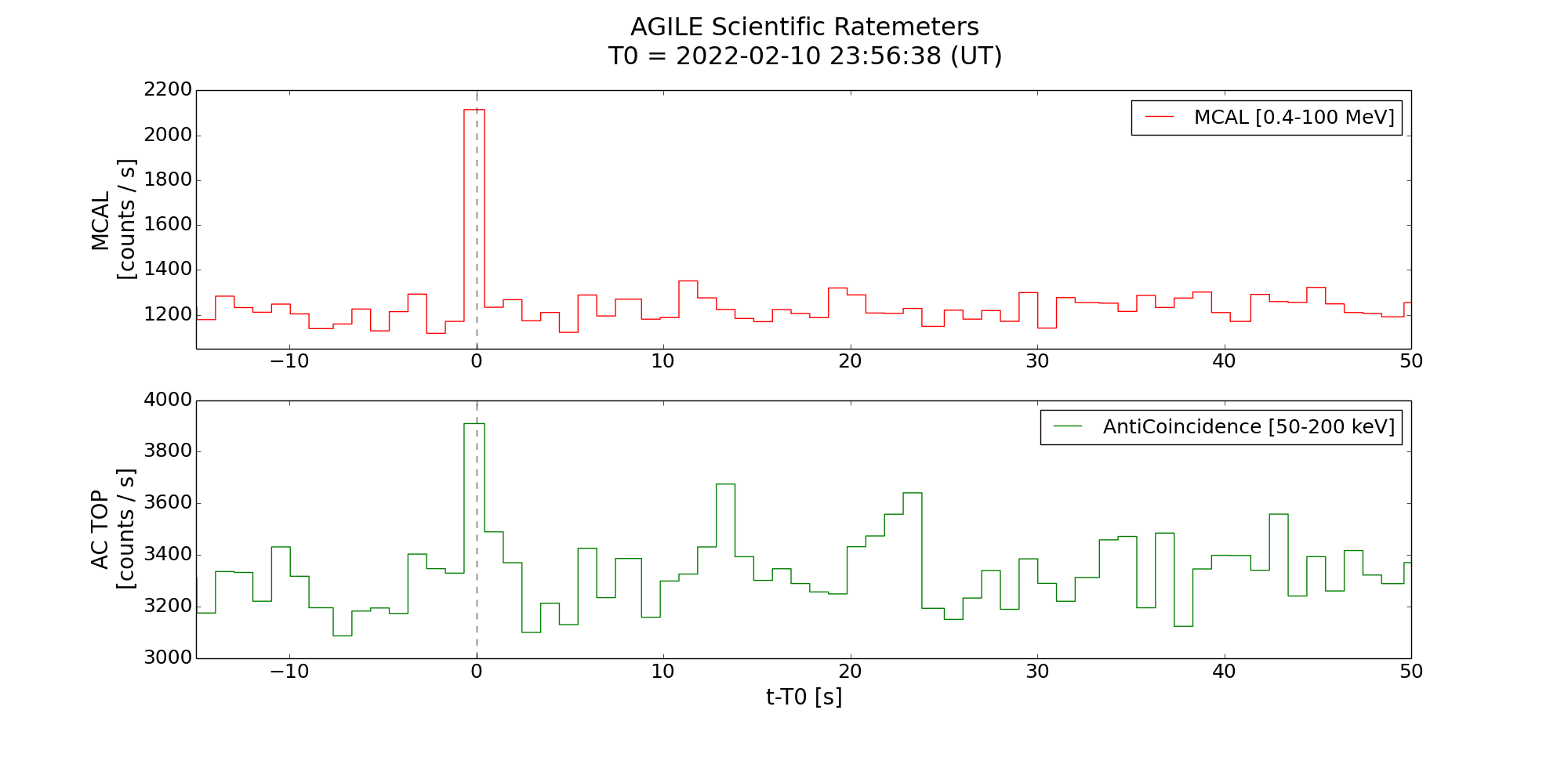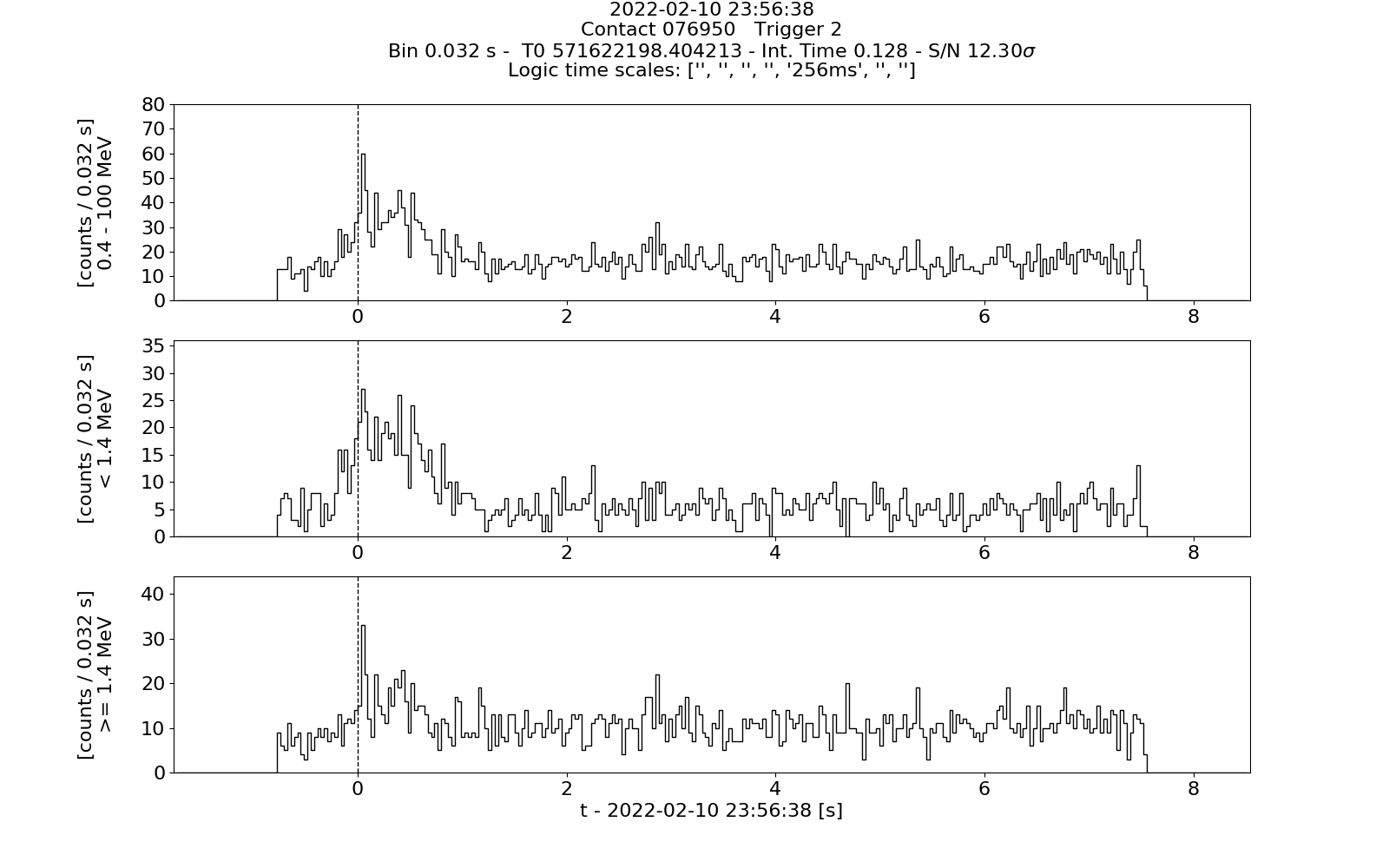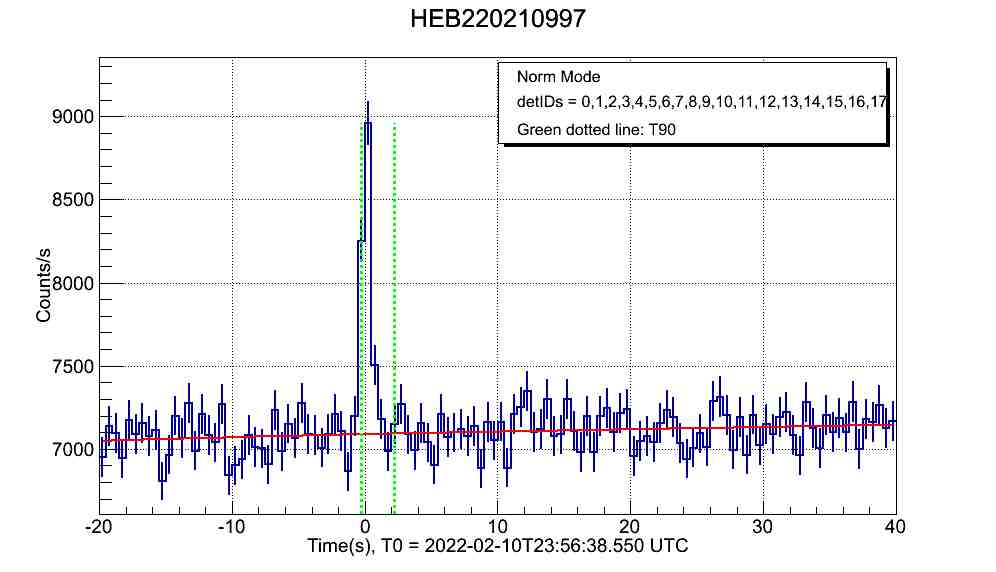- GCN NOTICE
TITLE: GCN/FERMI NOTICE
NOTICE_DATE: Thu 10 Feb 22 23:57:03 UT
NOTICE_TYPE: Fermi-GBM Flight Position
RECORD_NUM: 50
TRIGGER_NUM: 666230203
GRB_RA: 320.167d {+21h 20m 40s} (J2000),
320.209d {+21h 20m 50s} (current),
320.067d {+21h 20m 16s} (1950)
GRB_DEC: +71.833d {+71d 49' 60"} (J2000),
+71.928d {+71d 55' 40"} (current),
+71.620d {+71d 37' 11"} (1950)
GRB_ERROR: 8.55 [deg radius, statistical plus systematic]
GRB_INTEN: 255 [cnts/sec]
DATA_SIGNIF: 9.80 [sigma]
INTEG_TIME: 1.024 [sec]
GRB_DATE: 19620 TJD; 41 DOY; 22/02/10
GRB_TIME: 86198.37 SOD {23:56:38.37} UT
GRB_PHI: 300.00 [deg]
GRB_THETA: 15.00 [deg]
DATA_TIME_SCALE: 1.0240 [sec]
HARD_RATIO: 0.60
LOC_ALGORITHM: 3 (version number of)
MOST_LIKELY: 89% GRB
2nd_MOST_LIKELY: 4% Generic Transient
DETECTORS: 0,1,0, 1,0,0, 0,0,0, 0,0,0, 0,0,
SUN_POSTN: 324.59d {+21h 38m 22s} -14.10d {-14d 05' 55"}
SUN_DIST: 86.08 [deg] Sun_angle= 0.3 [hr] (West of Sun)
MOON_POSTN: 77.24d {+05h 08m 58s} +24.65d {+24d 39' 14"}
MOON_DIST: 74.43 [deg]
MOON_ILLUM: 72 [%]
GAL_COORDS: 108.03, 15.37 [deg] galactic lon,lat of the burst (or transient)
ECL_COORDS: 39.12, 72.02 [deg] ecliptic lon,lat of the burst (or transient)
LC_URL: http://heasarc.gsfc.nasa.gov/FTP/fermi/data/gbm/triggers/2022/bn220210998/quicklook/glg_lc_medres34_bn220210998.gif
COMMENTS: Fermi-GBM Flight-calculated Coordinates.
COMMENTS: This trigger occurred at longitude,latitude = 246.72,24.97 [deg].
COMMENTS: The LC_URL file will not be created until ~15 min after the trigger.
- GCN NOTICE
TITLE: GCN/FERMI NOTICE
NOTICE_DATE: Thu 10 Feb 22 23:57:20 UT
NOTICE_TYPE: Fermi-GBM Ground Position
RECORD_NUM: 60
TRIGGER_NUM: 666230203
GRB_RA: 348.040d {+23h 12m 10s} (J2000),
348.267d {+23h 13m 04s} (current),
347.529d {+23h 10m 07s} (1950)
GRB_DEC: +65.710d {+65d 42' 36"} (J2000),
+65.830d {+65d 49' 50"} (current),
+65.438d {+65d 26' 16"} (1950)
GRB_ERROR: 5.51 [deg radius, statistical only]
DATA_SIGNIF: 13.40 [sigma]
DATA_INTERVAL: 1.024 [sec]
GRB_DATE: 19620 TJD; 41 DOY; 22/02/10
GRB_TIME: 86198.37 SOD {23:56:38.37} UT
GRB_PHI: 350.00 [deg]
GRB_THETA: 12.00 [deg]
E_RANGE: 44.032 - 279.965 [keV]
LOC_ALGORITHM: 4173 (Gnd S/W Version number)
SUN_POSTN: 324.59d {+21h 38m 22s} -14.10d {-14d 05' 55"}
SUN_DIST: 81.87 [deg] Sun_angle= -1.6 [hr] (East of Sun)
MOON_POSTN: 77.24d {+05h 08m 58s} +24.65d {+24d 39' 16"}
MOON_DIST: 67.22 [deg]
MOON_ILLUM: 72 [%]
GAL_COORDS: 112.95, 4.78 [deg] galactic lon,lat of the burst (or transient)
ECL_COORDS: 35.24, 60.48 [deg] ecliptic lon,lat of the burst (or transient)
LC_URL: http://heasarc.gsfc.nasa.gov/FTP/fermi/data/gbm/triggers/2022/bn220210998/quicklook/glg_lc_medres34_bn220210998.gif
POS_MAP_URL: http://gcn.gsfc.nasa.gov/notices_f/gbm_gnd_loc_map_666230203.fits
COMMENTS: Fermi-GBM Ground-calculated Coordinates.
COMMENTS: In the LAT Field-of-view.
COMMENTS: Bright hard burst in the GBM.
COMMENTS: This Notice was ground-generated -- not flight-generated.
COMMENTS: The LC_URL file will not be created/available until ~15 min after the trigger.
COMMENTS: The POS_MAP_URL file will not be created/available until ~1.5 min after the notice.
- GCN NOTICE
TITLE: GCN/FERMI NOTICE
NOTICE_DATE: Thu 10 Feb 22 23:58:05 UT
NOTICE_TYPE: Fermi-GBM Ground Position
RECORD_NUM: 0
TRIGGER_NUM: 666230203
GRB_RA: 329.020d {+21h 56m 05s} (J2000),
329.132d {+21h 56m 32s} (current),
328.765d {+21h 55m 04s} (1950)
GRB_DEC: +69.670d {+69d 40' 12"} (J2000),
+69.776d {+69d 46' 32"} (current),
+69.432d {+69d 25' 54"} (1950)
GRB_ERROR: 3.39 [deg radius, statistical only]
DATA_SIGNIF: 12.10 [sigma]
DATA_INTERVAL: 6.144 [sec]
GRB_DATE: 19620 TJD; 41 DOY; 22/02/10
GRB_TIME: 86198.37 SOD {23:56:38.37} UT
GRB_PHI: 314.00 [deg]
GRB_THETA: 14.00 [deg]
E_RANGE: 44.032 - 279.965 [keV]
LOC_ALGORITHM: 41731 (Gnd S/W Version number)
SUN_POSTN: 324.59d {+21h 38m 22s} -14.10d {-14d 05' 55"}
SUN_DIST: 83.93 [deg] Sun_angle= -0.3 [hr] (East of Sun)
MOON_POSTN: 77.25d {+05h 09m 00s} +24.66d {+24d 39' 20"}
MOON_DIST: 72.92 [deg]
MOON_ILLUM: 72 [%]
GAL_COORDS: 108.70, 11.80 [deg] galactic lon,lat of the burst (or transient)
ECL_COORDS: 35.05, 68.66 [deg] ecliptic lon,lat of the burst (or transient)
LC_URL: http://heasarc.gsfc.nasa.gov/FTP/fermi/data/gbm/triggers/2022/bn220210998/quicklook/glg_lc_medres34_bn220210998.gif
POS_MAP_URL: http://gcn.gsfc.nasa.gov/notices_f/gbm_gnd_loc_map_666230203.fits
COMMENTS: Fermi-GBM Ground-calculated Coordinates.
COMMENTS: In the LAT Field-of-view.
COMMENTS: This is likely a Long GRB.
COMMENTS: This Notice was ground-generated -- not flight-generated.
COMMENTS: The LC_URL file will not be created/available until ~15 min after the trigger.
COMMENTS: The POS_MAP_URL file will not be created/available until ~1.5 min after the notice.
COMMENTS:
COMMENTS: NOTE: This GBM event is temporally(1.0<100sec) coincident with the CALET_GBM event (trignum=1328572556).
- GCN NOTICE
TITLE: GCN/FERMI NOTICE
NOTICE_DATE: Thu 10 Feb 22 23:58:21 UT
NOTICE_TYPE: Fermi-GBM Ground Position
RECORD_NUM: 1
TRIGGER_NUM: 666230203
GRB_RA: 328.630d {+21h 54m 31s} (J2000),
328.749d {+21h 55m 00s} (current),
328.359d {+21h 53m 26s} (1950)
GRB_DEC: +68.640d {+68d 38' 24"} (J2000),
+68.745d {+68d 44' 43"} (current),
+68.403d {+68d 24' 09"} (1950)
GRB_ERROR: 3.10 [deg radius, statistical only]
DATA_SIGNIF: 14.70 [sigma]
DATA_INTERVAL: 11.264 [sec]
GRB_DATE: 19620 TJD; 41 DOY; 22/02/10
GRB_TIME: 86198.37 SOD {23:56:38.37} UT
GRB_PHI: 317.00 [deg]
GRB_THETA: 15.00 [deg]
E_RANGE: 44.032 - 279.965 [keV]
LOC_ALGORITHM: 41731 (Gnd S/W Version number)
SUN_POSTN: 324.59d {+21h 38m 22s} -14.10d {-14d 05' 54"}
SUN_DIST: 82.90 [deg] Sun_angle= -0.3 [hr] (East of Sun)
MOON_POSTN: 77.25d {+05h 09m 00s} +24.66d {+24d 39' 21"}
MOON_DIST: 73.49 [deg]
MOON_ILLUM: 72 [%]
GAL_COORDS: 107.93, 11.09 [deg] galactic lon,lat of the burst (or transient)
ECL_COORDS: 32.29, 68.42 [deg] ecliptic lon,lat of the burst (or transient)
LC_URL: http://heasarc.gsfc.nasa.gov/FTP/fermi/data/gbm/triggers/2022/bn220210998/quicklook/glg_lc_medres34_bn220210998.gif
POS_MAP_URL: http://gcn.gsfc.nasa.gov/notices_f/gbm_gnd_loc_map_666230203.fits
COMMENTS: Fermi-GBM Ground-calculated Coordinates.
COMMENTS: In the LAT Field-of-view.
COMMENTS: This is likely a Long GRB.
COMMENTS: This Notice was ground-generated -- not flight-generated.
COMMENTS: The LC_URL file will not be created/available until ~15 min after the trigger.
COMMENTS: The POS_MAP_URL file will not be created/available until ~1.5 min after the notice.
COMMENTS:
COMMENTS: NOTE: This GBM event is temporally(1.0<100sec) coincident with the CALET_GBM event (trignum=1328572556).
- GCN NOTICE
TITLE: GCN/FERMI NOTICE
NOTICE_DATE: Fri 11 Feb 22 00:06:04 UT
NOTICE_TYPE: Fermi-GBM Final Position
RECORD_NUM: 0
TRIGGER_NUM: 666230203
GRB_RA: 7.910d {+00h 31m 38s} (J2000),
8.225d {+00h 32m 54s} (current),
7.202d {+00h 28m 49s} (1950)
GRB_DEC: +61.530d {+61d 31' 48"} (J2000),
+61.652d {+61d 39' 07"} (current),
+61.254d {+61d 15' 14"} (1950)
GRB_ERROR: 5.00 [deg radius, statistical only]
GRB_DATE: 19620 TJD; 41 DOY; 22/02/10
GRB_TIME: 86198.37 SOD {23:56:38.37} UT
GRB_PHI: 36.00 [deg]
GRB_THETA: 13.00 [deg]
E_RANGE: 44.032 - 279.965 [keV]
LOC_ALGORITHM: 41731 (Gnd S/W Version number)
SUN_POSTN: 324.60d {+21h 38m 24s} -14.10d {-14d 05' 48"}
SUN_DIST: 83.17 [deg] Sun_angle= -2.9 [hr] (East of Sun)
MOON_POSTN: 77.32d {+05h 09m 17s} +24.67d {+24d 39' 59"}
MOON_DIST: 58.58 [deg]
MOON_ILLUM: 72 [%]
GAL_COORDS: 120.57, -1.25 [deg] galactic lon,lat of the burst (or transient)
ECL_COORDS: 40.96, 51.30 [deg] ecliptic lon,lat of the burst (or transient)
LC_URL: http://heasarc.gsfc.nasa.gov/FTP/fermi/data/gbm/triggers/2022/bn220210998/quicklook/glg_lc_medres34_bn220210998.gif
LOC_URL: http://heasarc.gsfc.nasa.gov/FTP/fermi/data/gbm/triggers/2022/bn220210998/quicklook/glg_locplot_all_bn220210998.png
COMMENTS: Fermi-GBM Final Position.
COMMENTS: This Notice was ground-generated -- not flight-generated.
COMMENTS: The LC_URL file should be available by the time this FINAL notice is produced.
COMMENTS: This notice was generated completely by automated pipeline processing.
COMMENTS: In the LAT Field-of-view.
COMMENTS: This is likely a Long GRB.
COMMENTS:
COMMENTS: NOTE: This GBM event is temporally(1.0<100sec) coincident with the CALET_GBM event (trignum=1328572556).
- GCN Circular #31568
The Fermi GBM team reports the detection of a likely LONG GRB
At 23:56:38 UT on 10 Feb 2022, the Fermi Gamma-ray Burst Monitor (GBM) triggered and located GRB 220210A (trigger 666230203.371058 / 220210998).
The on-ground calculated location, using the Fermi GBM trigger data, is RA = 7.9, Dec = 61.5 (J2000 degrees, equivalent to J2000 00h 31m, 61d 30'), with a statistical uncertainty of 5.0 degrees.
The angle from the Fermi LAT boresight is 13.0 degrees.
The skymap can be found here:
https://heasarc.gsfc.nasa.gov/FTP/fermi/data/gbm/triggers/2022/bn220210998/quicklook/glg_skymap_all_bn220210998.png
The HEALPix FITS file, including the estimated localization systematic, can be found here:
https://heasarc.gsfc.nasa.gov/FTP/fermi/data/gbm/triggers/2022/bn220210998/quicklook/glg_healpix_all_bn220210998.fit
The GBM light curve can be found here:
https://heasarc.gsfc.nasa.gov/FTP/fermi/data/gbm/triggers/2022/bn220210998/quicklook/glg_lc_medres34_bn220210998.gif

- GCN Circular #31569
V. Lipunov, V.Kornilov, E.Gorbovskoy, K.Zhirkov, N.Tyurina, P.Balanutsa, A.Kuznetsov,
D. Vlasenko, G.Antipov, D.Zimnukhov, V.Senik, T.Pogrosheva, E.Minkina,
A.Chasovnikov, V.Topolev, V.Grinshpun, D.Kuvshinov, D. Cheryasov
(Lomonosov Moscow State University, SAI, Physics Department),
R. Podesta, C.Lopez, F. Podesta, C.Francile
(Observatorio Astronomico Felix Aguilar OAFA),
R. Rebolo, M. Serra
(The Instituto de Astrofisica de Canarias),
D. Buckley
(South African Astronomical Observatory),
O.A. Gres, N.M. Budnev
(Irkutsk State University, API),
B.L.Carrasco, J.R.Valdes,V.Chavushyan, C.J.Martinez, V.M.Patino Alvarez,
M.L.H.Rodriguez (INAOE, OAGH)
A. Tlatov, D. Dormidontov
(Kislovodsk Solar Station of the Pulkovo Observatory),
A. Gabovich, V.Yurkov
(Blagoveschensk Educational State University)
MASTER-IAC robotic telescope (Global MASTER-Net: http://observ.pereplet.ru, Lipunov et al., 2010, Advances in Astronomy, vol. 2010, 30L) located in Spain (IAC Teide Observatory) started inspect of the Fermi GRB 220210A ( Fermi GBM team, GCN 31568) errorbox 552 sec after notice time and 587 sec after trigger time at 2022-02-11 00:06:25 UT, with upper limit up to 16.7 mag. The observations began at zenith distance = 78 deg. The sun altitude is -68.6 deg.
The galactic latitude b = -1 deg., longitude l = 121 deg.
Real time updated cover map and OT discovered available here:
https://master.sai.msu.ru/site/master2/observ.php?id=1878625
We obtain a following upper limits.
Tmid-T0 | Date Time | Site | Coord (J2000) |Filt.| Expt. | Limit| Comment
_________|_____________________|_____________________|____________________________________|_____|_______|_______|________
647 | 2022-02-11 00:06:25 | MASTER-IAC | (00h 31m 39.20s , +61d 20m 50.9s) | P| | 120 | 16.7 |
647 | 2022-02-11 00:06:25 | MASTER-IAC | (00h 30m 02.27s , +61d 27m 11.3s) | P- | 120 | 16.1 |
The observation and reduction will continue.
The message may be cited.
- GCN Circular #31572
Aaron Tohuvavohu (U Toronto), James DeLaunay (UAlabama), Gayathri
Raman (PSU), Jamie A. Kennea (PSU), report:
Swift/BAT did not localize GRB 220210A onboard (T0: 2022-02-10T23:56:38
UTC, Fermi/GBM GCN 31568, CALET trig 1328572556).
The Fermi and CALET notices, distributed in near real-time, triggered
the Swift Mission Operations Center operated Gamma-ray Urgent Archiver
for Novel Opportunities (GUANO; Tohuvavohu et al. 2020, ApJ, 900, 1).
Upon trigger, GUANO sent a command to the Swift Burst Alert Telescope
(BAT) to save 200 seconds of BAT event-mode data from [-50,+150]
seconds around the time of the burst. All the requested event mode
data was delivered to the ground.
The GRB is clearly detected in the BAT data, with a duration of ~15 seconds.
A location for the burst is found with conventional BAT imaging, with SNR 11.4.
While the derived location is precise to ~2 arcminute with respect to
the spacecraft pointing, the conversion to celestial coordinates is
complicated by the current operational mode of Swift (GCN 31500,
31547).
The BAT position is
RA, Dec = 345.778, +61.826 deg which is
RA(J2000) = 23h 03m 6.9s
Dec(J2000) = +61d 49′ 33.2″
with an estimated uncertainty of 2 arcmin with respect to the
spacecraft pointing.
The uncertainty in the Swift attitude in the current mode is believed
to be ~1-2 degrees (M. Ajello et al, 2008 ApJ 689, 666).
The position is consistent with the Fermi/GBM localization (GCN 31568).
NITRATES results are not yet available, and will be reported in a
future circular.
There will be no XRT/UVOT followup (GCN 31547).
We encourage followup from other instruments.
GUANO is a fully autonomous, extremely low latency, spacecraft
commanding pipeline designed for targeted recovery of BAT event mode
data around the times of compelling astrophysical events to enable
more sensitive GRB searches.
- GCN Circular #31573
I. M. Carrasco-Garcia (UMA), A. J. Castro-Tirado, M.D. Caballero-Garcia,
Y.-D. Hu, T.-R. Sun, E. Fernandez-Garcia, R. Sanchez-Ramirez and I.
Olivares (IAA-CSIC), D. Hiriart and W. H. Lee (UNAM), S.
Castillo-Carrion and C. J. Perez del Pulgar (UMA) and I. H. Park (SKKU)
on behalf of a larger collaboration, report:
The 60cm BOOTES-5/JGT robotic telescope at Observatorio Astronomico
Nacional in San Pedro Martir (Mexico) observed the Swift/BAT-GUANO error
box for GRB 220210A (Tohuvavohu et al., GCNC 31572) also detected by
Fermi (The Fermi Team, GCNC 31568) starting at 04:35 UT (i.e. 4.6 h post
burst). In the single clear images (60 s exposure), we find an
uncataloged optical source at (J2000) coordinates RA: 23:03:17.1,
DEC:+61:49:36.6 (+/- 1”) within the Swift/BAT-GUANO error box and for
which we measure a preliminary magnitude R = 18.5 mag. We propose this
source to be the GRB 220210A optical afterglow, pending confirmation of
its variability. Further multicolour observations are ongoing.
Spectroscopic observations are encouraged.
We thank the staff at San Pedro Martir for their support.
- GCN Circular #31574
I. M. Carrasco-Garcia (UMA) and A. J. Castro-Tirado (IAA-CSIC) on behalf of a larger collaboration, report:
The optical afterglow candidate reported in GCNC 31573 (Carrasco-Garcia et al.) is ruled out as it is detected in DDS-2 Infrared Survey and therefore is a highly reddened object unrelated to the GRB. We apologize for the inconveniences this may have caused. Further observations are still ongoing at San Pedro Martir reaching a limiting magnitude of 20.5.
- GCN Circular #31575
A. Ursi, L. Foffano (INAF/IAPS), F. Verrecchia, C. Pittori (SSDC, and
INAF/OAR), M. Tavani (INAF/IAPS, and Univ. Roma Tor Vergata), A. Argan, M.
Cardillo, C. Casentini, Y. Evangelista, E. Menegoni, G. Piano (INAF/IAPS),
F. Lucarelli (SSDC, and INAF/OAR), A. Bulgarelli, A. Di Piano, V. Fioretti,
F. Fuschino, N. Parmiggiani (INAF/OAS-Bologna), M. Marisaldi
(INAF/OAS-Bologna, and Bergen University), M. Pilia, A. Trois
(INAF/OA-Cagliari), I. Donnarumma (ASI), A. Giuliani (INAF/IASF-Mi), F.
Longo (Univ. Trieste and INFN Trieste), and P. Tempesta (TeleSpazio),
report on behalf of the AGILE Team:
The AGILE satellite detected the long GRB 220210A at T0 = 2022-02-10
23:56:38.40 +/- 0.01 s (UTC), reported by Fermi GBM (GCN #31568) and Swift
BAT (GCN #31572).
The burst is clearly visible in the AGILE scientific ratemeters of the
MiniCALorimeter (MCAL; 0.4-100 MeV) and AntiCoincidence (AC; 50-200 keV)
detectors. The event lasted about 1.9 s (in the 0.4-100 MeV energy range)
and it released a total number of 2110 counts in the MCAL detector (above a
background rate of 1230 Hz), and 3910 counts in the AC detector (above a
background rate of 3330 Hz). The AGILE ratemeters light curves can be found
at http://www.agilescienceapp.it/notices/GRB220210A_AGILE_RM.png .
The event also triggered a high time resolution MCAL data acquisition,
which released 1440 counts in the detector, above a background rate of 505
Hz. The time-integrated spectrum of the burst, from T0-0.19 s to T0+1.73 s,
can be fitted in the energy range 0.4-5 MeV with a power-law with ph.ind. =
-1.81 (-0.19,+0.21), resulting in a reduced chi-squared of 1.18 (36 d.o.f.)
and a fluence of 3.40e-06 erg/cm^2 (90% confidence level), in the same
energy range. The MCAL light curve can be found at
http://www.agilescienceapp.it/notices/076950_GRB_571622198.404213.png . At
the T0, the event was 15 deg off-axis.
Additional analysis of AGILE data is in progress. Automatic MCAL GRB alert
Notices can be found at: https://gcn.gsfc.nasa.gov/agile_mcal.html.


- GCN Circular #31576
F. Longo (University and INFN, Trieste), F. Piron (CNRS/IN2P3/LUPM), M. Axelsson (KTH & Stockholm Univ.), M.Ohno (Hiroshima Univ. & Eotvos Univ.), E. Bissaldi (Politecnico and INFN, Bari) and N. Di Lalla (Stanford) report on behalf of the Fermi-LAT Collaboration:
On February 10th, 2022, Fermi-LAT detected high-energy emission from GRB 220210A, which was also detected by Fermi-GBM (GCN 31568) Swift/BAT-GUANO (GCN 31572) and AGILE (GCN 31575). The best LAT on-ground location is found to be
RA, Dec = 347.4, 61.1 (degrees, J2000)
with an error radius of 1.5 deg (90% containment, statistical error only).
This was 15 deg from the LAT boresight at the time of the GBM trigger:
T0 = 23:56:38 UT.
The data from the Fermi-LAT show a significant increase in the event rate after the GBM trigger that is temporally correlated with the GBM emission with high significance. The GRB has a very soft estimated photon index (above 50 MeV) of -3.3 +/- 0.5 in the time interval 0-30 s after the GBM trigger. The corresponding estimated photon flux above 50 MeV is 3.8 +/- 1.4 E-5 ph/cm2/s. The highest-energy photon is a 190 MeV event which is observed 1 second after the GBM trigger.
The Fermi-LAT point of contact for this burst is Niccolo' di Lalla (niccolo.dilalla@stanford.edu)
The Fermi-LAT is a pair conversion telescope designed to cover the energy band from 20 MeV to greater than 300 GeV. It is the product of an international collaboration between NASA and DOE in the U.S. and many scientific institutions across France, Italy, Japan and Sweden.
- GCN Circular #31580
C. Malacaria (USRA), P. Veres (UAH) and C. Meegan (UAH)
report on behalf of the Fermi GBM Team:
"At 23:56:38.37 UT on 10 February 2022, the Fermi Gamma-Ray Burst Monitor (GBM)
triggered and located GRB 220210A (trigger 666230203 / 220210998),
which was also detected by the Swift/BAT-GUANO (Tohuvavohu et al. 2022, GCN 31572),
Fermi-LAT (Longo et al. 2022, GCN 31576), and AGILE (Ursi et al. 2022, GCN 31575).
The Fermi GBM Final Real-time Localization (GCN 31568) is consistent with the Swift position.
The angle from the Fermi LAT boresight at the GBM trigger time is 16 degrees.
The GBM light curve shows a main peak followed by fainter peaks
with a duration (T90) of about 43 s (10-1000 keV).
The time-averaged spectrum from T0-0.4 s to T0+2.7 s is
best fit by a power-law function with an exponential high-energy cutoff.
The power law index is -0.95 +/- 0.07 and the cutoff energy,
parameterized as Epeak, is 3530 +/- 986 keV.
The event fluence (10-1000 keV) in this time interval is
(4.9 +/- 0.3)E-06 erg/cm^2. The 1-sec peak photon flux measured
starting from T0-0.192 s in the 10-1000 keV band
is 4.1 +/- 0.2 ph/s/cm^2.
The spectral analysis results presented above are preliminary;
final results will be published in the GBM GRB Catalog:
https://heasarc.gsfc.nasa.gov/W3Browse/fermi/fermigbrst.html
For Fermi GBM data and info, please visit the official Fermi GBM Support Page:
https://fermi.gsfc.nasa.gov/ssc/data/access/gbm/"
- GCN Circular #31581
Y.-D. Hu, F. Aceituno, T.-R. Sun, A. J. Castro-Tirado, M. D. Caballero-Garcia, R. Sanchez-Ramirez and E. Fernandez-Garcia (IAA-CSIC), on behalf of a larger collaboration, report:
Following the detection of GRB 220210A by Fermi (Fermi Team, GCNC 31568), Swift (Tohuvavohu et al. GCNC 31572) and AGILE (Ursi et al. GCNC 31575), we triggered the 1.5m OSN telescope in Granada (Spain) starting on Feb 11 at 19:30 UT (i.e. ~19.6 h post burst). Five images covering the Swift/BAT-GUANO error region were taken in the I-band at high airmass. No optical afterglow is detected in the error box down to I=20.8 in the combined (5x300s) image, in agreement with the non-detections reported by Lipunov et al. (GCNC 31569) and Carrasco-Garcia et al. (GCNC 31574).
We thank the staff at OSN for their excellent support.
- GCN Circular #31583
S. L. Xie, S. L. Xiong, X. B. Li, C. Cai, Q. Luo, S. Xiao,
J. C. Liu, W. C. Xue, Q. B. Yi, C. Zheng,Y. Huang, C. K. Li,
G. Li, J. Y. Liao, X. Y. Song, S. L. Xiong, C. Z. Liu,
X. F. Li, Z. W. Li, Z. Chang, A. M. Zhang, Y. F. Zhang,
X. F. Lu, C. L. Zou (IHEP), Y. J. Jin, Z. Zhang (THU),
T. P. Li (IHEP/THU), F. J. Lu, L. M. Song, Y. Q. Zhang
M. Wu, Y. P. Xu, S. N. Zhang (IHEP),
report on behalf of the Insight-HXMT team:
At 2022-02-10T23:56:38.550 (T0), Insight-HXMT/HE detected
GRB 220210A (trigger ID: HEB220210997) in a routine search of the data,
which also triggered Fermi/GBM (Fermi GBM Team, GCN #31568),
Swift/BAT (D'Ai A. et al., GCN #31572)
The Insight-HXMT/HE light curve mainly consists of single
pulse with a duration (T90) of 35.17 s measured from T0+2.60 s.
The 1-ms peak rate, measured from T0-0.064 s, is 1992 cnts/sec.
The total counts from this burst is 1726 counts.
URL_LC: http://twiki.ihep.ac.cn/pub/HXMT/GRBList/HEB220210997_lc.jpg
All measurements above are made with the CsI detectors operating in the
regular mode with the energy range of about 80-800 keV (deposited energy).
Only gamma-rays with energy greater than about 200 keV can penetrate
the spacecraft and leave signals in the CsI detectors installed inside
of the telescope.
Insight-HXMT is the first Chinese space X-ray telescope, which was
funded jointly by the China National Space Administration (CNSA) and
the Chinese Academy of Sciences (CAS).
More information about it could be found at:
http://www.hxmt.org.

- GCN Circular #31586
N. Pankov (HSE), A. Pozanenko (IKI), E. Klunko (ISZF), R. Ya.
Inasaridze (AbAO), I. Sokolov (INASAN, KIAM), I. Izvekova (Institute of
Physics of NAS, ICAMBR of NAS), A. Shein (INASAN), Y. Markus (Institute
of Physics of NAS, ICAMBR NAS), Y. Markelov (KIAM), G. Butenko (ICAMBR
NAS), S. Belkin (IKI, HSE) report on behalf of GRB IKI:
We observed the field of Swift/BAT-GUANO localization (Tohuvavohu et
al., GCN 31572) of GRB 220210A (Fermi GBM team, GCN 31568) with
AZT-33IK telescope of Mondy observatory, AS-32 telescope of Abastumani
observatory, and Zeiss-2000 telescope in R-filter. Within localization
area (Tohuvavohu et al., GCN 31572) we do not detect evident candidate
in comparison with SDSS DR12 catalogue. The object reported by BOOTES
team (Carrasco-Garcia et al., GCN 31573) is clearly visible in all of
our observations and do not show significant variability with R= 20.17
+/- 0.14 (0.54116 d), R= 20.05 +/- 0.13 (0.72701 d), and R=20.14 +/-
0.13 (0.77438 d). This highly reddened object visible in DDS-2 Infrared
Survey (Carrasco-Garcia et al., GCN 31574) is also presented in SDSS
DR12 as a star-like very red object with r=21.187.
Preliminary photometry of the field is following
Date UT start t-T0 Filter Exp. OT Err UL(3sigma) Telescope
2022-02-11 12:32:54 0.54116 R 23*120 n/d n/d 22.7 AZT-33IK
2022-02-11 16:58:32 0.72701 R 50*60 n/d n/d 21.9 AS-32
2022-02-11 19:41:36 0.77438 R 35*180 n/d n/d 22.2 Zeiss-2000
The photometry is based on the nearby USNO-B1.0 stars
RA DEC R2
345.7846139 61.8542256 14.69
345.7584140 61.8282804 17.76
![]() Previous IAU Circulars
Previous IAU Circulars 


